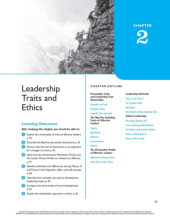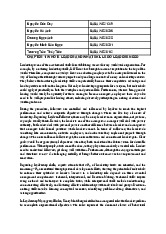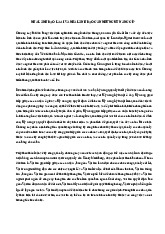



Preview text:
THE INTERNATIONAL UNIVERSITY (IU) – VIETNAM NATIONAL UNIVERSITY – HCMC SUBJECT: LEADERSHIP MIDTERM EXAMINATION Date: August 19, 2021 Duration: 90 minutes
Student ID: BABAWE17493 Name: Từ Mỹ Duyên SUBJECT: LEADERSHIP
School of Business Administration Lecturer Signature: Signature: Full name:
Full name: Assoc. Prof. Mai Ngoc Khuong (PhD.) GENERAL INSTRUCTION(S)
• This is a open book examination
• Write your answer below each question directly in this Microsoft Word File
• Use your own English to reflect your understanding and applications of your leadership knowledge
• Your answers will be checked PLAGIARISM with SafeAssign, students can not view the
orginality report (Pls don’t copy and paste)
• Submission: Single Attempt is applied. Please check your work carefully before submision.
1. Discuss the relationship between power and politics, how should a leader ethically use his/her
power and political behaviors at work? (20 points)
Power and politics have strong connection and go together, power is the ability of you to get
someone to do what you ask them to do or not allow to do. In other words, influence “through
persuasion or coercion”. There are 7 types of power: legitimate, reward, coercive, referent,
expert, information and connection. Politics is the process of gaining and using power, the
politic behavior include networking, reciprocity and coalition, networking means that you make
friend and socialize with them, talking and try to understand them, then reciprocity is develop
the relationship and make them to join your clan, alliance to come together as a team and work
to accomplish the certain objectives, coalition is support each other rather than compete.
To lead an effective organization, you need power and the use of power which is politics to
force employees to work and do what they are asked to do. It is without difficulty to abuse the
power and politics to urge, order staff doing something illegal or unethical. So a leader should
ethically use his/her power and politics in the right way and do not overuse it for their own
benefits, advantages of themselves. Thus, leader should use 50% of their power and effectively
use politics for the profit of the whole organization.
2. Provide discussions and personal applications (with concrete examples) of your most favorit 4
tools/skills that a leader needs to influence employees. (20 points)
communication: develop a good relationship with employees, treat them as brother, as family,
talking to understand their needs and try to get close with the employees, speak to them in
appropriate tone. Be helpful when they needed, for example, when they’re upset, you should look
for the reasons, maybe they are struggle with disease so they need money to pay the bill or their
family have lost member or something that they don’t tell you, but you should figure out some ways
Feedback: before comment on your employees work, you should appreciate their effort and say
“well done”, “you are doing great job” something like that to them. After that, evaluating closely
and make a clear feedback so they can know what to fix and do better, you can give them some
advice, suggestion to make them change in a good way
Coaching: when coaching them, you should be a good example and be a role model for them to
follow, describe the desired performance by modeling for them to imitate, using step by step
instruction and encourage them when they’re not doing right and give praise and recognition when they’re doing right
Conflict solving: when conflict happened, you have to understand it will usually occur because it is
inevitable, and your job is to find solution, such as communicate in diver ways to make up and
discover misunderstanding and to know more about your employees, being fair and justice when
having argument or fighting among members, using the approach win-win strategy, intergrative
bargain, try to be collaborating and not saying bad words or competing to your employees cause it
is useless and just make things worse, try to see things in their perspective and thinking in their
position to know why they was doing this. After that, solve the conflict by sharing feeling and
appreciate them. From that, the bond between leader and employees will be closer and tight
3. Describe all the inspirational leadership approaches? How are you going to improve and apply
your charismatic and transformational leadership at work. (20 points)
First, understand myself like knowing the strengths, weaknesses and the environment best suited for
me, then choose which leadership style is the best fit for me base on that. Next, I will enhance my soft
skills especially the communication skill because charismatic leadership is the process you influence
other through communication and inspire them by your vision, your passion and your ideal of life and
sharing the same dream, goals; Try to be helpful to other teammates and involve in the work of helping
them solve problems. Be passionate of what I’m doing and be hard working, when doing things wrong,
be positive and figure out the solution to fix it, knowing that mistakes is inevitable, error will always
happen and my job is to learn from it and get up from failure.
To improve my charismatic and transformational leadership, I will learn and practice myself every day
and take every opportunity to exercise what I have learned, think and write down my vision and my
mission, like what I’m going to do next 3 years, who I will become, what make me dedicate to work
for and what success looks like, thinking about the spiritual outlook on life and live follow it, develop
my rules in life to discipline myself and treat other people base on these rules. Then inspire other about
my vision and dreams, encourage them to do the same and make them understand why they should
follow it and passionate to achieve the goals. To build credibility and gain the respect from others, I
have to be a role model, make myself a right example for them to follow. Aligning my words and
actions will help to build trust and make followers do what I said. Moreover, I need to communicate
well with my staff, such as, knowing their needs, listening to their difficulty and clarifying
misunderstandings, sharing valuable information and cheer them up when it needed. And when
employees do their job well or they achieve some difficult goals, a good leader will recognize the
achievement and find ways to celebrate it, this let them know that their work are valued and appreciated.
To make people give their best in work, they must have a sense of ownership over their job and believe
that what they are doing is meaningful, tell them clear goals and deadlines, then give them the authority
to decide how their work gets done, challenge them with high expectations and encourage them to be
creative and innovated. And when facing the tough decision making, I need to analyze the consequences
and positive result, thinking about backup plans when it doesn’t work, above all is to take responsible of it and stick to the plan.
4. Case Analysis - Columbia Corporation (40 points)
Columbia Corp. is a young, rapidly growing company that manufactures computer accessories and
specialized components for networked computer workstations. It has some unique products and a
strong reputation for quality. However, the market is very competitive, and continued success requires
innovation and high-quality products. The company currently employs 500 people, a number that has
doubled in the past three years. Sales have nearly tripled in the same period, and a recent contract with
a large computer company will increase sales even more. However, along with this success the
company is also experiencing some problems. Quality rejects have begun to increase, and in recent
months the company failed repeatedly to meet delivery schedules.
The top executives include Matt Walsh, CEO and founder of the company, and the vice presidents of
production, engineering, sales, and accounting. Walsh is a forceful manager who tightly controls
important decisions in the company. The other executives are required to get his approval before
making any significant changes in operations. Walsh’s style has been to deal with each VP separately,
rather than meeting as a group to address problems. Relationships between departments have been
deteriorating for the past two years. Distrust, competition, and political maneuvering have increased,
and Walsh intervenes frequently to resolve conflicts between executives. The distrust and hostility has
spilled over to relationships among lower-level employees of the departments.
The production VP believes that the rash of quality problems is the result of frequent changes in product
design by the engineering department. The production supervisors have little warning of these changes
and insufficient time to determine how to make necessary adjustments in production methods. As for
the delivery problems, the production VP believes that the sales department makes unrealistic promises
to win new customers. Production capacity has not increased fast enough to meet the growing volume
of orders, and additional delays are caused by product modifications designed for customers by
engineering. The sales VP blames the late deliveries on manufacturing delays. She believes the
production people spend so much time trying to correct quality problems that they can’t get the product
out the door. The sales VP and the engineering VP both believe the production VP is set in his ways
and unwilling to adapt to the special needs of important customers.
The sales VP is upset with the accounting VP for tightening customer credit requirements without prior
notice. She only discovered the new policy when a key customer complained after credit was denied
on a large order. The sales VP believes the new policy will reduce sales, and the reduction will be
blamed on her. She complained to Walsh, who apparently approved the decision without understanding
the implications. The accounting VP also upset the production VP by abruptly canceling all overtime
for production employees for the remainder of this month. This action appears unwarranted, and it put
production even farther behind schedule. The production VP has asked Walsh to reverse this decision.
Concerned about the growing problems, Walsh asked a management consultant for advice on what to
do. The consultant told Walsh that he needs an effective top management team that will work together
smoothly to guide the company through this period of rapid, turbulent growth. The executive team
needs to become more adept at understanding and resolving key problems such as insufficient
production capacity and declining quality. Walsh asked the consultant for advice on how to create an
effective top management team that would take responsibility for shaping the future direction of the
company. This change would be consistent with his desire to become less involved in the day-to-day
management of the company so that he can spend more time in outside pursuits. The company has
made him a millionaire, and he wants to begin enjoying some of the benefits from his success as an
entrepreneur. He finds dealing with the day-to-day problems of managing an established company
much less fulfilling than it was to create a new company. QUESTIONS
1. What issues must be resolved to create an effective executive team?
2. What types of changes should be considered?
3. To what extent is Matt Walsh part of the problem?
4. If Walsh decided to retire, and you were hired from the outside to be the new CEO, explain
brieflywhat you would do during your first year on the job.
1. The product design should be stable and should not be changed so frequently, the distrust and
competition between departments should be resolve, the tightening customer credit
requirements without prior notice should be expand. The CEO needs to include all the VPs in
the decision-making process and hold joint meetings rather than individual meetings to share new ideas.
2. Developmental and operational changes
3. His problem is that engage team and solve their problem in a whole picture, see the problem as
overall, not just look in detail, and have to gather every department to work together as a team
to understand difficulty of each other. From that, they can solve the problem properly




